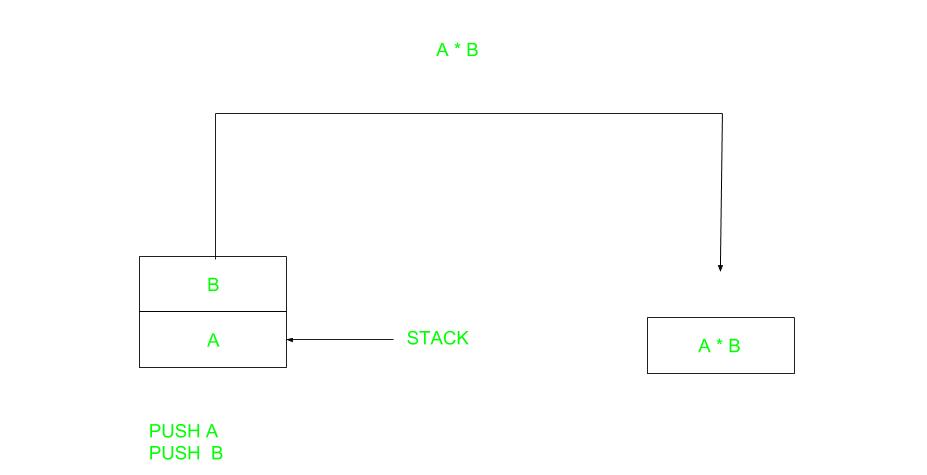This instruction format can be coded from 1 to 6 bytes depending upon the addressing modes used for instructions. Control fetches the instruction from.

Instruction Formats For Mips Architecture 1 Download Scientific Diagram
For example the opcode for MOV is 100010.

. Vertical Format called Vertical microcode. There are three types of formats. Example - ADD R1CB --- R1.
Register - reference instruction. In implied addressing the operand is specified in the instruction itself. Types of instructions.
In this lesson we defined what an addressing mode is and examples of several different types of addressing modes. For example the instruction that specifies an arithmetic addition is defined by an assembly language instruction as ADD. A temporary location T is used to store some intermediate result so as not to.
A instruction in computer comprises of groups called fields. The figure displayed the general IA-32 Intel Architecture- 32 bits instruction format. The ADD instruction in this case results in the operation AC AC MX.
Types of Instructions Different assembly language instructions are mainly categories into the following main types. In a branch-type instruction the address field specifies the actual branch address. The addressing mode is the method to specify the operand of an instruction.
Where X is the address of the operand. Memory - reference instruction. It uses 12 bits to specify the address and 1 bit to specify the addressing mode I.
A register called program counter PC is used to computer the address of the next instruction and the process of the execution of instruction continues. A basic computer has three instruction code formats which are. Memory - reference instruction.
These instructions are recognized by the opcode 111 with a 0 in the left most bit of instruction. Each instruction has two parts. One is task to be performed called the operation code opcode and the second is the data to be operated on called the operand.
Computer perform task on the basis of instruction provided. Examples include ARM MIPS OpenRISC SPARC x86 z architecture Intel 8080 Transputer Transmeta Crusoe Elbrus 2000 Itanium Cryptoleq NI1000 and CM1K. Mnemonics are abbreviations of the name of operation being executed.
Three address Instruction With this type of instruction each instruction specifies two operand location and a result location. 3Data transfer instructions 5Arithmetic instructions 7Logical and program control instructions. Here the instructions format has three different address fields specifying or memory or processor register operand.
Every Instruction has a unique 6-bit opcode. Have 2 registers and a constant value immediately present in the instruction. An instruction is a command to the microprocessor to perform a given task on a specified data.
In this type of instruction one operand is placed in a specified register such as an accumulator and the address of the next instruction is obtained from another register called program counter PC. In this mode the data is 8 bits or 16 bits long and data is the part of instructionZero address instruction are designed with implied addressing mode. Indirect Address Mode In this mode the address field of the instruction gives the address where the effective address is stored in memory.
The operand resides in memory and its address is given directly by the address field of the instruction. Computers may have instructions of several different lengths containing varying number of addresses. Horizontal Format called Horizontal microcode.
Following are the types of instructions. I is equal to 0 for direct address and 1 for indirect address. Each of these formats provides a trade off in terms of the control store size and the speed of operation of the control unit.
B One-address instruction c Two-address instruction. The first part of each instruction called MNEMONIC refers to the operation an instruction performs copy addition logic operation etc. Types of microinstruction formats.
A Three Address instructions - In these type of instructions all operand addresses are explicitly defined. The other 12 bits specify the operation. IA-32 is the instruction format that can Intels most outstanding microprocessors.
The opcode field has 1 or 2 bytes. Source register 5 bits rt. The Opcode stands for Operation Code.
Three Two One and Zero Address Instruction -. We have demonstrated examples of instruction set architectures from various categories such as RISC CISC MISC VLIW EPIC OISC and ZISC. The instruction format in this type of computer uses one address field.
In Memory-reference instruction 12 bits of memory is used to specify an address and one bit to specify the addressing mode I. 5 rows The one address instruction format makes use of an implied accumulator for all data manipulation. The general Instruction format that most of the instructions of the 8086 microprocessor follow is.
Instruction set Examples of Instruction Sets. Common Instruction Formats Four common instruction formats. There are three types of microinstruction formats.
This instruction format includes four fields such as opcode field addressing mode field displacement field and immediate field. These field contains different information as for computers every thing is in 0 and 1 so each field has different significance on. Types of address instructions Three address instructions Memory addresses for the two operands and one destination need to be specified.
These instructions are responsible of transfer of data among. Destination register 5 bits immediate value 16 bits Instructions that follow typical format. Instruction Format - Programming of 8085 Processor.

Computer Organization Instruction Formats Zero One Two And Three Address Instruction Geeksforgeeks

Computer Organization Instruction Formats Zero One Two And Three Address Instruction Geeksforgeeks

Various Instructions Code Formats Addressing Mode Segmentation Direct Address
0 Comments